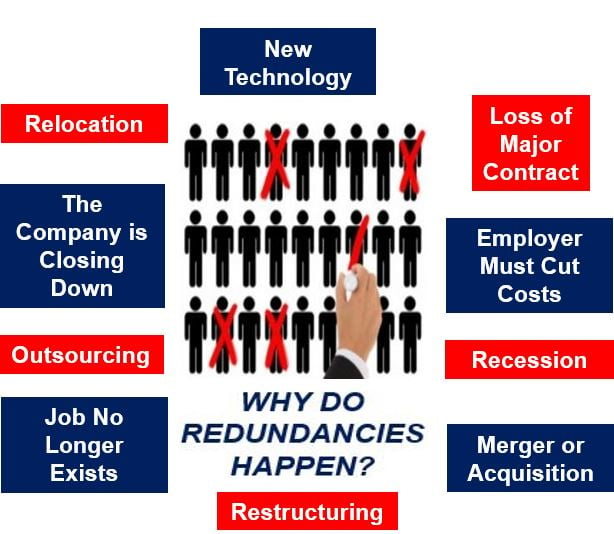How to Handle Redundancy Pay If Company Goes Bust: Key Details for UK Employees
How to Handle Redundancy Pay If Company Goes Bust: Key Details for UK Employees
Blog Article
Exploring the Interplay Between Firm Redundancy and Organizational Adaptability for Future Development
In the dynamic landscape of today's organization globe, the detailed relationship between business redundancy and business flexibility emerges as a crucial element for sustained development and success. Firms usually face the challenge of striking a delicate equilibrium in between keeping a level of redundancy to mitigate risks and promoting versatility to react quickly to the ever-evolving market needs.
Relevance of Company Redundancy
Company redundancy is an important aspect that improves business durability and alleviates functional dangers. By including redundancy actions within the business structure, business can better stand up to unanticipated disturbances and variations in the business setting. Redundancy works as a critical barrier, enabling firms to adjust and respond efficiently to unexpected challenges without endangering vital operations.
One key facet of the relevance of company redundancy is its duty in making certain continuity during times of situation. When confronted with unexpected changes or emergencies, redundant systems, sources, or workers can action in to maintain essential features and stop prevalent interruptions. This continuity not just safeguards the business's credibility and customer trust fund but also decreases monetary losses and functional downtime.

Strategies for Organizational Versatility

One more essential method is buying modern technology and infrastructure that can support versatility and scalability. Carrying out electronic devices, automation, and data analytics can improve operations, enhance effectiveness, and give beneficial understandings for educated decision-making. Moreover, producing versatile business frameworks that permit fast changes to market characteristics and consumer demands is essential for remaining affordable in a swiftly advancing setting. By proactively recognizing possible disturbances and possibilities, companies can proactively flourish and adapt in an ever-changing company landscape.
Balancing Redundancy and Adaptability
Achieving an unified stability find between operational redundancy and business adaptability is vital in browsing the complexities of a dynamic organization environment. Striking the ideal equilibrium between redundancy and versatility is a fragile procedure that requires a deep understanding of the organization's goals, sector characteristics, and risk tolerance.
To accomplish this balance, business require to carry out routine evaluations of their procedures to determine areas where redundancy is required for threat mitigation and where versatility can drive technology and development. Carrying out adaptable frameworks, cultivating a society of continual discovering and enhancement, and motivating open interaction throughout all degrees of the company are key strategies to balance redundancy and flexibility efficiently. By straightening these two crucial components, firms can place themselves for sustainable growth and success in an ever-changing company landscape.
Case Studies on Adjustment Success
In analyzing circumstances of effective business adjustment, it becomes apparent that the interplay in between functional redundancy and flexibility is a specifying element in shaping durable organizations. A DVD rental solution, Netflix showed remarkable adaptability by transitioning into a streaming platform when digitalization interrupted the market. These situation research studies highlight the value of functional redundancy paired with business flexibility in cultivating lasting development and competition.
Structure Strength for Future Development
Structure strength for future development requires a strategic alignment of operational processes with market dynamics and emerging fads. Firms have to adjust to altering atmospheres by promoting a culture of flexibility, development, and constant enhancement. Resilience includes not just jumping back from setbacks but also proactively preparing for future challenges. One essential aspect of structure durability is buying durable threat administration strategies to minimize prospective interruptions. This consists of situation preparation, expanding supply visit this site chains, and developing backup strategies for various backups (who pays redundancy money).
Furthermore, fostering solid relationships with stakeholders, such as consumers, employees, distributors, and the community, is crucial for weathering unpredictabilities and maintaining count on and assistance during unstable times. Website Effective interaction and openness play an important function in structure resilience, as they assist promote and align assumptions cooperation in navigating unpredictabilities.
Moreover, companies need to prioritize discovering and growth initiatives to upskill employees and furnish them with the essential devices to adapt to transforming situations. By spending in their labor force, firms can enhance their adaptability and agility, eventually enhancing their strength for lasting future development.
Conclusion

In the vibrant landscape of today's company globe, the elaborate connection in between company redundancy and organizational flexibility emerges as a vital element for continual development and success. Companies frequently encounter the obstacle of striking a fragile equilibrium between preserving a degree of redundancy to mitigate dangers and promoting flexibility to respond quickly to the ever-evolving market needs.To achieve this balance, business require to perform regular assessments of their operations to recognize locations where redundancy is necessary for risk mitigation and where versatility can drive technology and development.In conclusion, the interplay between business redundancy and business flexibility is crucial for future growth. Building resilience with a combination of redundancy and versatility will certainly make sure that firms are prepared for the obstacles of the future.
Report this page